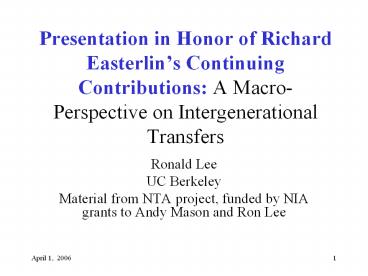Presentation in Honor of Richard Easterlin
Title:
Presentation in Honor of Richard Easterlin
Description:
Presentation in Honor of Richard Easterlin s Continuing Contributions: A Macro-Perspective on Intergenerational Transfers Ronald Lee UC Berkeley – PowerPoint PPT presentation
Number of Views:4
Avg rating:3.0/5.0
Title: Presentation in Honor of Richard Easterlin
1
Presentation in Honor of Richard Easterlins
Continuing Contributions A Macro-Perspective on
Intergenerational Transfers
- Ronald Lee
- UC Berkeley
- Material from NTA project, funded by NIA grants
to Andy Mason and Ron Lee
2
Comparative International Scope
- Main NIA funded project, Lee and Mason teams for
each country. - United States
- Taiwan
- Japan
- Indonesia
- Chile
- Brazil
- France
- Additional countries funded by UNFPA, Ogawa at
Nihon Univ. - China
- India
- Philippines
- Thailand
- Uruguay (in-country UNFPA support)
- Individuals in additional countries may
participate with own funding - Sweden
- S. Korea
- Austria
- Slovenia
3
References downloadable from http//www.schemear
ts.com/proj/nta/web/nta/show/Working20Papers
- Ronald Lee and Andrew Mason, A Research Plan for
the Macroeconomic Demography of Intergenerational
Transfers, January 2004. - Antoine Bommier, Ronald Lee, Timothy Miller, and
Stephane Zuber, Who wins and who loses? Public
transfer accounts for US generations born 1850 to
2090, December 2004. - Andrew Mason, Ronald Lee, An-Chi Tung, Mun-Sim
Lai, and Tim Miller, forthcoming. Population
Aging and Intergenerational Transfers
Introducing Age into National Accounts,
Economics of Aging Series, David Wise, ed. NBER
and University of Chicago Press. - Ronald Lee, Sang-Hyop Lee, and Andrew Mason.
Charting the Economic Life-Cycle, November 2005
(under review)
4
1. Reallocation of income across age groups
- Flows of income from individuals of one age to
those of another age are a pervasive part of our
everyday life, but from the point of view of
national accounts they are largely invisible. - Some of these flows are attracting a lot of
piecewise attention in terms of micro level
motivations (investment in children, care for
elderly parents, bequests, Social Security,
Medicare) - Big picture is largely ignored.
5
2. The economic life cycle Labor earnings and
consumption per capita
Output per person per year
Labor earnings, yl(x)
Consumption, c(x)
- - - -
- - - - -
- - -
- - - - -
Age
6
3. Resource Reallocation Across Age and Time
Form of Reallocation Family Institution Market Public Sector
Capital HouseCarConsumer DurablesInventoriesEducation Factories Inventories Farms Social Infrastructure(Hospitals, Roads,Airports, Govt. Bldgs)
Transfers Child RearingCollege CostsGiftsBequestsHelp to Elderly Government Debt Public EducationMedicaid, MedicareSocial SecurityFood StampsAFDC
Borrowing/ Lending Familial Loans"Transfers" with a quid pro quo Credit Markets (mortgages, credit cards, bond issues) Government Loans
7
4. A Fundamental Change The Historical Reversal
of Direction of Flows
- Some production and consumption profiles have
been estimated - Direction of flows is indicated by the population
weighted average ages of consumption and
production - See various articles for theory and mathematical
framework - Here go straight to results
8
2050
3
-2
United States Lee Miller
Lee, 2000, 2003 (see cv)
9
(No Transcript)
10
5. Estimated age profiles of production and
consumption
- These come from NTA project
- Research by teams working on US and Taiwan
- Looks simple actually a great deal of analysis
lies behind them.
11
(No Transcript)
12
(No Transcript)
13
What institutions and mechanisms provide the
flows that support these consumption patterns?
- Source by age
- Inter vivos familial transfers
- bequests
- Public transfers
- Through assets (credit and capital)
14
Source See Lee, Lee and Mason (2005).
15
Source See Lee, Lee and Mason (2005).
16
Mason, Lee, Tung, Mun-Sim Lai, and Miller (2005)
17
Mason, Lee, Tung, Mun-Sim Lai, and Miller (2005)
18
How the elderly fund consumption
Mason, Lee, TungMun-Sim Lai, and Miller (2005)
19
Another illustration of what can be done with
historical depth and projections
20
Net Present Values of Benefits minus Taxes for
Generations
- Includes only Public Educ, Social Sec, and
Medicare - NPVs calculated based on
- estimates and projections of age specific taxes
paid and benefits received, 1850-2200 - Discounted at 3 real
- actual or projected survival
21
Net Present Value at birth of expected life time
benefits for Social Security, Medicare and Public
Education as of lifetime earnings, for
generations born 1850 to 2090
Total
See Bommier, Lee, Miller and Zuber
22
USA and France A Comparison (see Stephane Zuber)
NPVs for the US
NPVs for France
23
USA and France Accounting for the differences
(1) seeStephane Zuber
Spending as Percent of GDP US
Spending as Percent of GDP France
24
The End



























![Huawei Honor V9- Set to launch on 22 February [Full Phone Specifications] PowerPoint PPT Presentation](https://s3.amazonaws.com/images.powershow.com/8767886.th0.jpg?_=20170211088)



